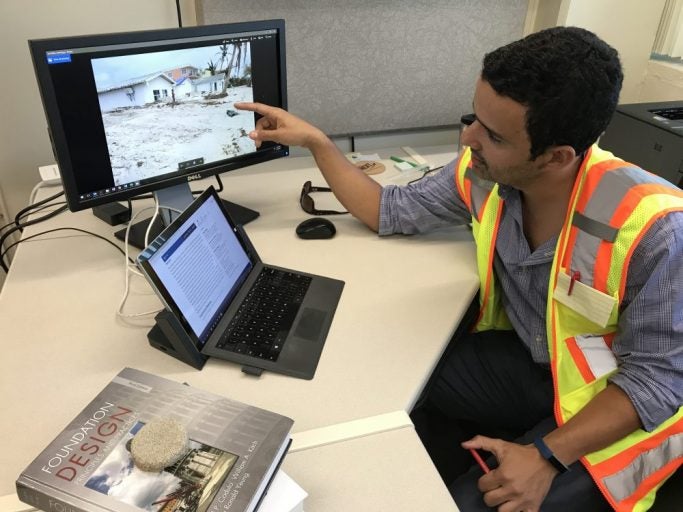Simple words spoken by an elderly woman in Cape Coral are an example of why UCF engineering Assistant Professor Luis Arboleda-Monsalve works so hard to make a difference in his profession, which in turn has a direct impact on hurricane readiness.
“She told us to make sure to do something good with the report,” said the structural and geotechnical engineer. “That’s what we are doing, issuing a set of recommendations about building codes and standards so we not only help infrastructure be more resistant, but also more resilient so that after the next disaster, people can return to their normal lives as quickly as possible.”
The woman was one of hundreds in Cape Coral who saw the canal seawalls behind their homes collapse under the brunt of Hurricane Irma last month. These walls help keep the canals from flooding homes, protect them from the wave impact, and keep the soil under the homes stable.
Arboleda-Monsalve was one of three researchers who traveled from Cape Coral to Everglades City, and from Miami to Key West, to take inventory of geotechnical and infrastructure damage caused by Hurricane Irma’s storm surge, waves and subsequent flooding.
Arboleda-Monsalve is part of the Geotechnical Extreme Events Reconnaissance Association, a National Science Foundation-funded group based at the University of California at Berkeley. The volunteer organization dispatches experts in civil engineering to areas hit by natural disasters. GEER’s mission is to turn disaster into knowledge that can be used for future improvement of engineering standards and practices nationwide. Reports with observations and recommendations are posted to the GEER website, creating a national, centralized hub of peer-reviewed post-storm technical reports that can help guide the community to create, improve or modify construction practices and codes.
GEER had teams in Texas after Hurricane Harvey, in Florida after Hurricane Irma, and in Mexico after a recent 7.1 magnitude earthquake. The GEER teams arrive after emergency personnel have assembled so they don’t get in the way of distributing services to people who need it.
Two teams worked in Florida following Irma. Arboleda-Monsalve’s team included Professor Nina Stark from Virginia Tech and Professor Inthuorn Sasanakul from the University of South Carolina. They focused on geotechnical damage on bridges, roads, canals and shoreline damage from hurricane-related erosion in the west and south side of Florida. Another team focused on the north and east part of the state. A different team of structural engineers handled damage caused by wind and focused on other parts of the state affected by the hurricane.
The team collected more than 1,500 photos, and the U.S. Geological Survey, NSF, Florida Division of Emergency Management and other agencies helped them gain access to areas and target the visit to the most affected areas in the state.
“We saw a lot of seawall collapses, especially the older seawalls. The newer ones did their job,” Arboleda-Monsalve said. “Riprap, typically used to prevent erosion under bridges and coastline, did help. We also saw a lot of exposed foundations and some areas decimated. I wasn’t prepared for the human toll.”
The first Irma report was uploaded to the GEER website last week. Reports about the earthquake in Mexico and other natural disasters, including massive flooding, landslides and tsunamis in the United States and around the world, also are posted on the GEER website. “In a few months the report about Irma will be updated to include official recommendations about codes and standards. This will happen after the teams have time to go through all the data collected during their visits, Arboleda-Monsalve said.
It’s civil engineers who come up with solutions and recommend codes and standards to help keep highrises from collapsing during earthquakes, bridges from failing under heavy truck loads and homes from being destroyed during tropical storms and hurricanes.
“I know I’m not curing cancer, but I am making a difference,” Arboleda-Monsalve said. “By researching how our work holds up in the real world and making recommended changes when needed, we are helping keep people safe. That person from Cape Coral, I’ll never forget her words. She reminded the team that it is our responsibility to help secure our shores from the next natural disaster.”
